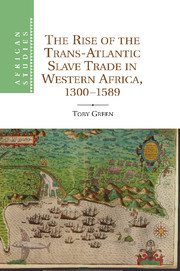Book contents
- Frontmatter
- Contents
- List of Maps
- Acknowledgements
- Abbreviations
- Glossary
- Introduction Rethinking the Trans-Atlantic Slave Trade from a Cultural Perspective
- Part One The Development Of An Atlantic Creole Culture In Western Africa, Circa 1300–1550
- Part Two Creolisation And Slavery
- 6 The Early Trans-Atlantic Slave Trade from Western Africa
- 7 Trading Ideas and Trading People
- 8 Cycles of War and Trade in the African Atlantic, circa 1550–1580
- 9 Creole Societies and the Pan-Atlantic in Late-Sixteenth-Century Western Africa and America
- Conclusion Lineages, Societies and the Slave Trade in Western Africa to 1589
- Bibliography
- Index
9 - Creole Societies and the Pan-Atlantic in Late-Sixteenth-Century Western Africa and America
from Part Two - Creolisation And Slavery
Published online by Cambridge University Press: 05 November 2011
- Frontmatter
- Contents
- List of Maps
- Acknowledgements
- Abbreviations
- Glossary
- Introduction Rethinking the Trans-Atlantic Slave Trade from a Cultural Perspective
- Part One The Development Of An Atlantic Creole Culture In Western Africa, Circa 1300–1550
- Part Two Creolisation And Slavery
- 6 The Early Trans-Atlantic Slave Trade from Western Africa
- 7 Trading Ideas and Trading People
- 8 Cycles of War and Trade in the African Atlantic, circa 1550–1580
- 9 Creole Societies and the Pan-Atlantic in Late-Sixteenth-Century Western Africa and America
- Conclusion Lineages, Societies and the Slave Trade in Western Africa to 1589
- Bibliography
- Index
Summary
The end of the sixteenth century saw important changes both within Western Africa and in the region’s Atlantic trade. Starting in 1580, a series of devastating droughts afflicted Cabo Verde. The droughts precipitated famines. Many Caboverdeans relocated to the coast of Upper Guinea. This accentuated the cultural and economic ties binding islands and coast and brought changes in the relationships between Upper Guineans and their Caboverdean and Iberian guests. In 1589 the lançados built a fortification at Cacheu in Brame territory. Here was an attempt to shift the landlord-stranger relationship onto a different footing.
This process produced major changes in the emerging creolised community in Western Africa. The arrival of many Caboverdeans swelled this community on the African mainland. Moreover, the fact that there had long been connections between Cabo Verde, the Caribbean islands and America meant that the pan-Atlantic nature of these communities on the African mainland was accentuated. As we have seen, the Kriolu language and mixed Atlantic cultural practices predated these events by some decades, and yet it was in these last years of the sixteenth century that the idea of a Creole community developed. The idea originated in the Americas, which itself stands as testament to the way in which global forces had come to influence local identities and responses in Western Africa by this time.
- Type
- Chapter
- Information
- Publisher: Cambridge University PressPrint publication year: 2011

